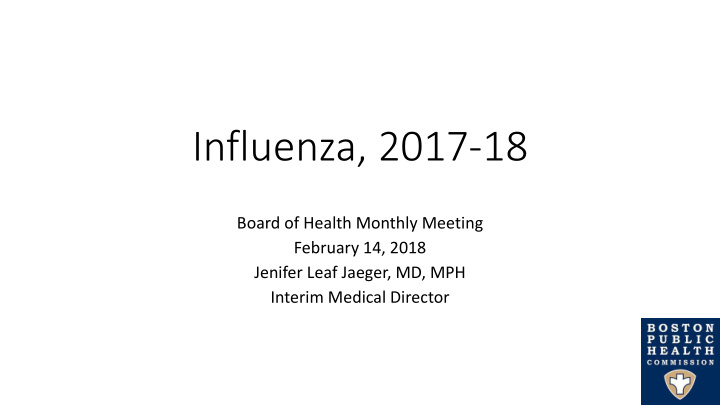



Influenza, 2017-18 Board of Health Monthly Meeting February 14, 2018 Jenifer Leaf Jaeger, MD, MPH Interim Medical Director
Influenza by the Numbers Annual Influenza-Related Illnesses in the United States, 2010-2016 • 9.2 - 35.6 million illnesses • 4.3 - 16.7 million medical visits • 140,000 - 710,000 hospitalizations • Includes ~20,000 children <5 years of age • 12,000 - 56,000 pneumonia/influenza deaths • Includes 37 - 171 deaths among children <5 • Rate of respiratory/circulatory deaths related to influenza is estimated to be 2-4 times greater. • Globally, 3-5 million cases resulting in 300,000-500,000 deaths annually.
Economic Burden of Seasonal Influenza in U.S. • $34.7 billion in direct medical and indirect costs associated with lost earnings and productivity, and lost lives. • Annual flu vaccine estimated to prevent 5.1 million influenza illnesses, 2.5 million medical visits, 71,000 hospitalizations, and 3,000 pneumonia/influenza deaths. • LHDs must engage in critical preparedness and response activities to mitigate flu and flu-related complications
Influenza – Boston, 2017-18 As of 2/3/2018 • 1,587 cases of laboratory-confirmed influenza among Boson residents • 312 (20%) have required hospitalization • 5 influenza-associated deaths have been reported • All deaths occurred in persons of advanced age or with multiple underlying medical conditions. • Emergency Department visits for influenza-like illness (ILI) comprised 5.23% of all ED visits Week 5 [up 2.17% from week prior] • MA ILI=5.88%; US ILI=7.65%
Geographic Distribution/Activity • State health departments voluntarily report the estimated level of geographic spread weekly • Reported as: no activity, sporadic, local, regional, or widespread • Geographic spread of influenza in Puerto Rico and 48 states reported as widespread • Regional activity (1); Local activity (1) • Per DPH (Week ending 2/3/18), %ILI increased 6% in NE MA, West and SE versus 2% in Greater Boston; Central MA has also been relatively spared
Geographic Distribution
Severity of Infection • Influenza-like illness (ILI) as % of ED visits • Hospitalization rates • Mortality rates • Pneumonia and Influenza • Pediatric Deaths
Weekly %ILI – Boston, 2012-2018
Weekly Hospitalizations – Boston, 2017-18 Confirmed Influenza-Related Hospitalizations, Case Count and as Percent of All Hospitalizations, by Week, 10/1/2017 – 2/3/2018 # Cases Hospitalized % Cases Hospitalized 80 70% 70 60% 60 % Hospitalized 50% # Hospitalized Cases 50 40% 40 30% 30 20% 20 10% 10 0 0% Week Ending *Boston residents only
Weekly %ILI – United States, 2009-2018
2017-18 Influenza Vaccine • As of February 3, 2017, among circulating wild-type influenza viruses tested, including influenza A(H3N2), no significant antigenic drift has been identified. • During the 2014- 15 season, the vaccine was considered a “bad match” with nearly 80% of circulating A(H3N3) virus differing from vaccine virus. • 98% of A(H3N2) viruses tested were well-inhibited by antibodies to virus representing the A(H3N2) component of 2017 – 18 Northern Hemisphere influenza vaccines.
BPHC Surveillance Systems • Robust surveillance system collecting flu data from multiple streams • Case reporting, social media, and syndromic surveillance collected from 12 acute care sites throughout Boston • Extensive historical data against which to compare the current year. • Healthcare providers and laboratories in Boston are required by city health department regulations to report all laboratory-confirmed cases of influenza and clusters of illness to the Infectious Disease Bureau.
Communicating with Healthcare Partners and the Community • Weekly Influenza Report sent electronically from MIC to HCPs, ED’s, emergency preparedness, and other external stakeholders • Epidemiologic data and trends-by-week; total case counts flu A and B; ILI as % of total ED cases seen to-date. • Lab-confirmed cases of influenza are analyzed by age, R/E, and neighborhood. Weekly counts are compared to the previous two influenza seasons. Weekly reports are posted on the BPHC website. • Health Alerts sent as necessary • Influenza among the homeless • At season end, data analyzed to identify trends and areas of concern. • Flu in Review sent to HCPs prior to the beginning of the next flu season, highlights trends from the previous year, provides recommendations for help HCPs prepare for the coming season.
Epi Curve of Influenza Cases in Boston Homeless Persons, N=55 2017-18 Season* # of Laboratory Confirmed Influenza Cases 8 7 6 5 4 3 2 1 0 Event Date**
Supply Chain • Vaccine • As of 2/7/18, CVS pharmacies reported limited supply of flu vaccine and had placed a repurchase order intended for the remainder of the season. Currently no shortages of vaccine at Walgreens or Rite Aid pharmacies. • Providers should instruct patients to contact their local pharmacy to confirm availability of vaccine or antiviral medication prior to filling their prescription. Pharmacies out of stock will redirect callers to other locations where product is available. • Antiviral medication • FDA has been informed of a brief shortage of Tamiflu Oral Suspension; otherwise no shortages of Tamiflu per commercial pharmacies • MassHealth confirmed coverage for Tamiflu if generic unavailable • Health Safety Net will also cover Tamiflu for uninsured patients • IV fluid • HHS granted waivers to 2 more plants to produce IVF • Plants in Puerto Rico back on electric grid, production anticipated to begin soon • Beds • Per DPH, % hospital beds for influenza patients increased ~40% • MA hospital network is currently handling this elevated patient load
Recommendations • Prevention • Providers should continue offering vaccine to all persons >6 months of age through the remainder of the season. • Vaccination reduces risk of infection, attenuates the severity of illness, including lower risk of flu-associated hospitalization and deaths particularly for children, pregnant women, and persons with chronic health conditions. • Covers influenza A(H1N1) and B strains currently increasing • Reduced Transmission • Cover cough; wash hands/hand sanitizer • Remain home if ill • Clean home, particularly high-touch surfaces • Treatment • No current resistance to antiviral medications (Tamiflu)
• Questions • Recommendations • What can we do better?
Recommend
More recommend